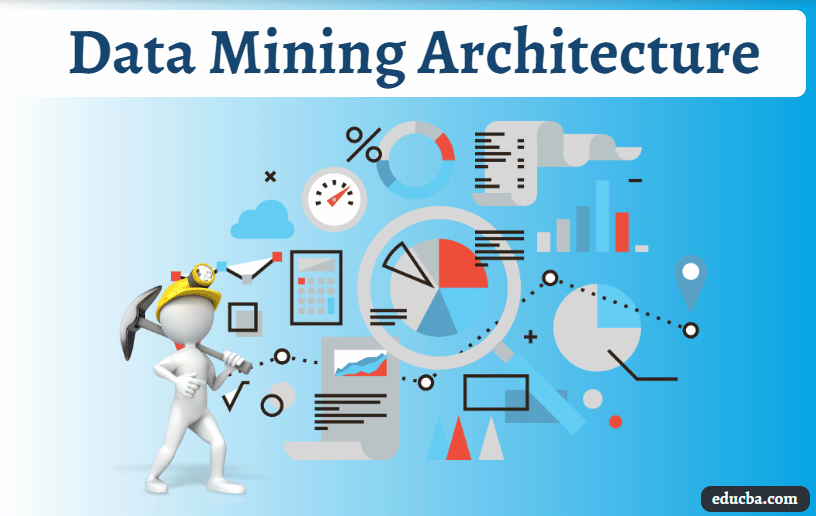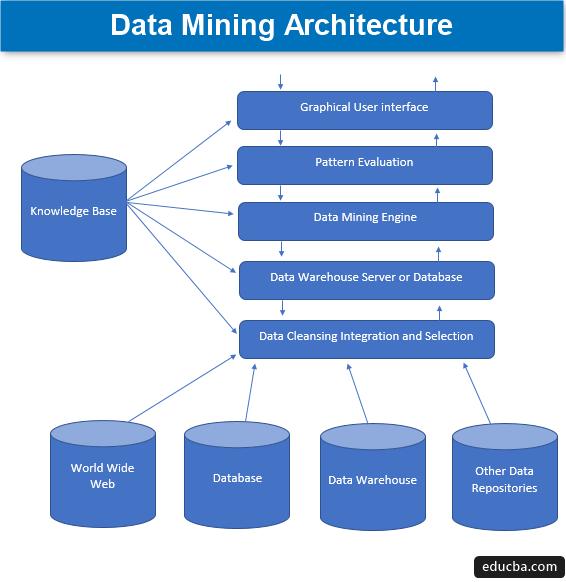Updated March 20, 2023

Overview of Data Mining Architecture
The data mining is the way of finding and exploring the patterns basic or of advanced level in a complicated set of large data sets which involves the methods placed at the intersection of statistics, machine learning, and database systems. It can be an interdisciplinary field of statistics and computer sciences where the goal is to extract the information using intelligent methods and techniques from a particular set of data through extraction and thereby transforming the data. The data management activities and data preprocessing activities and inference considerations, are also taken into consideration. In this article, we will dive deep into the architecture of data mining.
Data Mining Architecture
The data mining is the technique of extracting interesting knowledge from a set of huge amounts of data stored in many data sources such as file systems, data warehouses, and databases. The primary components of the data mining architecture involve –

1. Data Sources
A huge variety of present documents such as data warehouse, database, www or popularly called a World wide web become the actual data sources. Most of the times, it can also be the case that the data is not present in any of these golden sources but only in the form of text files, plain files or sequence files or spreadsheets and then the information needs to be processed in a very similar way as the processing would be done upon the data received from golden sources. Most of the major chunk of data today is obtained from the internet or the world wide web as everything present on the internet today is data in some form or another which forms some form of information repository units.
Before the data is processed ahead the different processes through which it goes involves data cleansing, integration, and selection before finally the information is passed onto the database or any of the EDW (enterprise data warehouse ) server. The major challenge that lies at times with this set of data is different sources and a wide array of data formats that form the data components. Therefore the data cannot be directly used for processing in its naïve state but processed, transformed and crafted in a much more usable way. This way, the reliability and completeness of the data are also ensured. The primary step involves data collection, cleaning and integration, and post that only the relevant data is passed forward. All this activity forms a part of a separate set of tools and techniques.
2. Data Warehouse Server or Database
The database server is the actual space where the data is contained once it is received from various data sources. The server contains the actual set of data which becomes ready to be processed, and therefore the server manages the data retrieval. All this activity is based on the request for data mining of the person.
3. Data Mining Engine
In data mining, the engine forms the core component and is the most vital part, or to say the driving force which handles all the requests and manages them and is used to contain several modules. The number of modules present includes mining tasks such as classification technique, association technique, regression technique, characterization, prediction and clustering, time series analysis, naive Bayes, support vector machines, ensemble methods, boosting and bagging techniques, random forests, decision trees, etc.
4. Pattern Evaluation Modules
This evaluation technique of the modules is mainly responsible for measuring the interestingness of all those patterns used for calculating the basic level of the threshold value and is used to interact with the data mining engine to coordinate in the evaluation of other modules. The main purpose of this component is to look out and search for all the interesting and useable patterns that could make the data of comparatively better quality.
5. Graphical User Interface
When the data is communicated with the engines and among various pattern evaluation of modules, it becomes a necessity to interact with the various components present and make it more user friendly so that the efficient and effective use of all the present components could be made and therefore arises the need of a graphical user interface popularly known as GUI.
This is used to establish a sense of contact between the user and the data mining system, thereby helping users access and use the system efficiently and easily to keep them devoid of any complexity arising in the process. This is a form of abstraction where only the relevant components are displayed to the users. All the complexities and functionalities responsible for building the system are hidden for simplicity. Whenever the user submits a query, the module then interacts with the overall set of a data mining system to produce a relevant output easily shown to the user in a much more understandable manner.
6. Knowledge Base
This is the component that forms the base of the overall data mining process as it helps in guiding the search or in the evaluation of interestingness of the patterns formed. This knowledgebase consists of user beliefs and the data obtained from user experiences, which are helpful in the data mining process. The engine might get its input set from the created knowledge base, thereby providing more efficient, accurate and reliable results.
Data mining is one of the most important techniques today that deals with data management and data processing, which forms any organisation’s backbone. Analysis of data in any organization will bring fruitful results. Each component of the data mining technique and architecture has its own way of performing responsibilities and completing data mining efficiently. The different modules are needed to interact correctly to produce a valuable result and complete the complex procedure of data mining successfully by providing the right set of information to the business.
Recommended Articles
This has been a guide to Data Mining Architecture. Here we discuss the brief overview with primary components of the data mining Architecture. You can also go through our other suggested articles to learn more –


